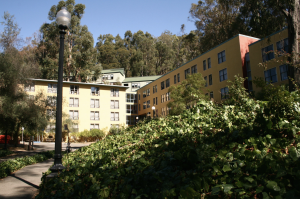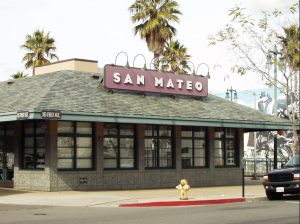By Hannah Phalen
Lina Buffington began her professional career pursuing her dream of becoming an academic, but as she engaged with more individuals who appeared to be on the brink of homelessness, her aspirations shifted and she eventually found herself invested in the issue of affordable housing. She had always been interested in the juvenile justice system, family courts, and child advocacy. These issues have remained a thread throughout her professional life. After working with a number of nonprofits with high risk young people including those in the foster care system and commercially sexually exploited youth, she noticed that many of the major problems in their lives came down to housing, or lack thereof. She explained, “I would often find myself in a situation where I was dealing with a young person who was trying really hard, and working really hard, and found themselves homeless, or found themselves without a safe place to be…I would do a lot of calling around looking for any place where they could go, and there was never anywhere they could go. Never… It would often be at the end of the day, myself and my staff closing down the office and I would have young folks in the office who had no place to go. And I knew that our only option was to send them out to the street. And that is a hard thing to do. A very… hard thing to do… but, (there were) no other options!”
In general, Lina has also always been concerned over gaps in equity and economic justice. She says that as she learned more, she realized just how important it was to be well informed on subjects like economics and finance. She explained that “…these were things I had never really invested in knowing or understanding before. I had accepted that this was sort of this world… out there… and that was all ‘ugly money stuff,’ but then one day I realized I couldn’t talk about economic justice if I didn’t understand how that ‘ugly money stuff’ works!” When she realized this, she began learning more about how land, real estate, and housing and all the ways in which those who have access to those things and those who do not are foundational to equity gaps. She joined groups that discussed these issues, but found herself wanting to do less idealizing, talking or dreaming and more action. “As someone who studied philosophy, I am no enemy of ideology; however, I am a pragmatist, so at a certain point, we have to do something! There’s only so much time I can put in to talking about stuff.” She eventually became more involved in an organization called Sustainable Economies Law Center (SELC). SELC had a model of cooperative ownership that they were piloting at that time, that was meant to open up new pathways for ownership and democratize ownership of real estate. Lina became very involved in this project and devoted about a year and a half of her life to it, eventually leading to her co-founding a new organization called the East Bay Permanent Real Estate Cooperative (EB PREC). While she eventually decided that this was not the project she wanted to devote herself to and passed on her role to others, she learned a lot from her time starting up this organization. One of the main challenges she had with the nonprofit nature of EB PREC and cooperatives in general was managing how to be sustainable without earning any profit. “So often, the work is so reliant on philanthropy, which is simply not reliable. It’s not sustainable. I’ve seen too often, too many times, where organizations are doing amazing and critical work have to close their doors due to something related to funding. And housing programs in particular, the structure of them, are very, very expensive. A lot of funders are way more hesitant to fund these programs because they are very expensive per person. A lot of investors want to see larger impact, like ‘If I spend this amount of dollars, I want it to have an effect on this amount of people, but this housing program is only gonna serve ten kids.’” Lina’s curiosity brought her to question whether there was a way to make these programs more financially viable to be able to manage and run more housing organizations.
Lina explained how other countries have policies that make it a lot easier to do things cooperatively. So much of housing depends on money, where you can get money, and how you can spend the money you do get. Because EB PREC was a cooperative entity, they had to follow regulations and restrictions about the kinds of money they could collect and how the money goes back out. She found it was difficult to do things at a larger scale. “Really when you’re talking about doing something at a larger scale, especially something like real estate,” she explains, “ you need investment dollars. And we could not really take investment dollars, especially not front end investment dollars. Start up investment costs are critical, especially with very expensive real estate endeavors and a market like this. Just getting a building or any piece of real estate here means you need a million dollars. And that’s not even including staff costs, the costs of managing and running things. It’s a lot of money! But the problem is, because of the way that the cooperative structure is set, it’s all connected to membership levels, and how much money can be given and how much can be paid back out. It’s almost impossible to get investment dollars because investors want to see output from their dollars. But with cooperatives, the money that is made has to go back to their members, which means there is not really anything left for investors. So you’re not going to get investors.” She realized she was putting so much time and effort into building a nonprofit, and she was not even really interested in building a nonprofit. “One of the problems with the nonprofit structure and community organizing structure… is that people often end up having to work for free or very little. And that is not sustainable. And it’s not a model I am interested in supporting anymore. We have to figure out how to do good work in a community in sustainable ways, which means that the people doing the work get paid.”
Another challenge she found was California’s regulations on condominiums. “Long story short, it is very difficult to bring the cooperative model to a larger scale. So, what you mostly see is individual housing developments with a small or medium group of people who put in their money and share work, which is fine and great, but it’s not really scalable and not really accessible when people don’t have the upfront money.” Throughout all her endeavors, she has concluded that because affordable housing is so expensive to create, to maintain, and to insure that it remains affordable that housing developers are all pushed to create more luxury units instead. To Lina, the system has so many flaws that many people are finding it to just be impossible. “It costs a lot more money, and they have to deal with the government more who lay out all these parameters and they have to check all these boxes that make the process just take a lot longer. It makes sense that they have to keep certain things in mind, but from a developer’s perspective, it’s like ‘Is it really worth it? If it’s so much easier to build luxury condos, then why not just keep building more luxury condos?’”
Looking to the future, Lina says we need to think more creatively and figure out how to do work outside of the traditional affordable housing versus market rate housing paradigm. “There’s a lot of interesting stuff happening in community investment. People are tweaking policies… and the mechanisms in that sector are interesting to me and can be fruitful. Folks are doing things cooperatively and I’ve seen many models. But in most cases, people are doing the work for free which is the main problem I see. We should be looking into what they’re doing in other countries. Even though it’s a completely different political and policy landscape, we could learn from them, keep spreading and creating more interesting projects that are doing something differently, and challenging some of the really unfortunate situations we have here …”. Lina continues to explain that “one of the most counterproductive paradigms that we have in this country is the investment versus donation paradigm… There are certain people we invest in, and then others who get our charity. And that is very problematic, and it only replicates inequity. So we have to continue to challenge that paradigm and say ‘No, we can invest in these people, and we can expect a return from that investment.’ And we are seeing that there are pretty significant returns on investment and a higher likelihood of return on investment in some of these community investment funds. That data is starting to come out and we are starting to see these things. So, the most important thing to do now is continue to do these projects, try new things, learn what’s out there. It’s the only way we can make any dent in the issue.”








Be First to Comment